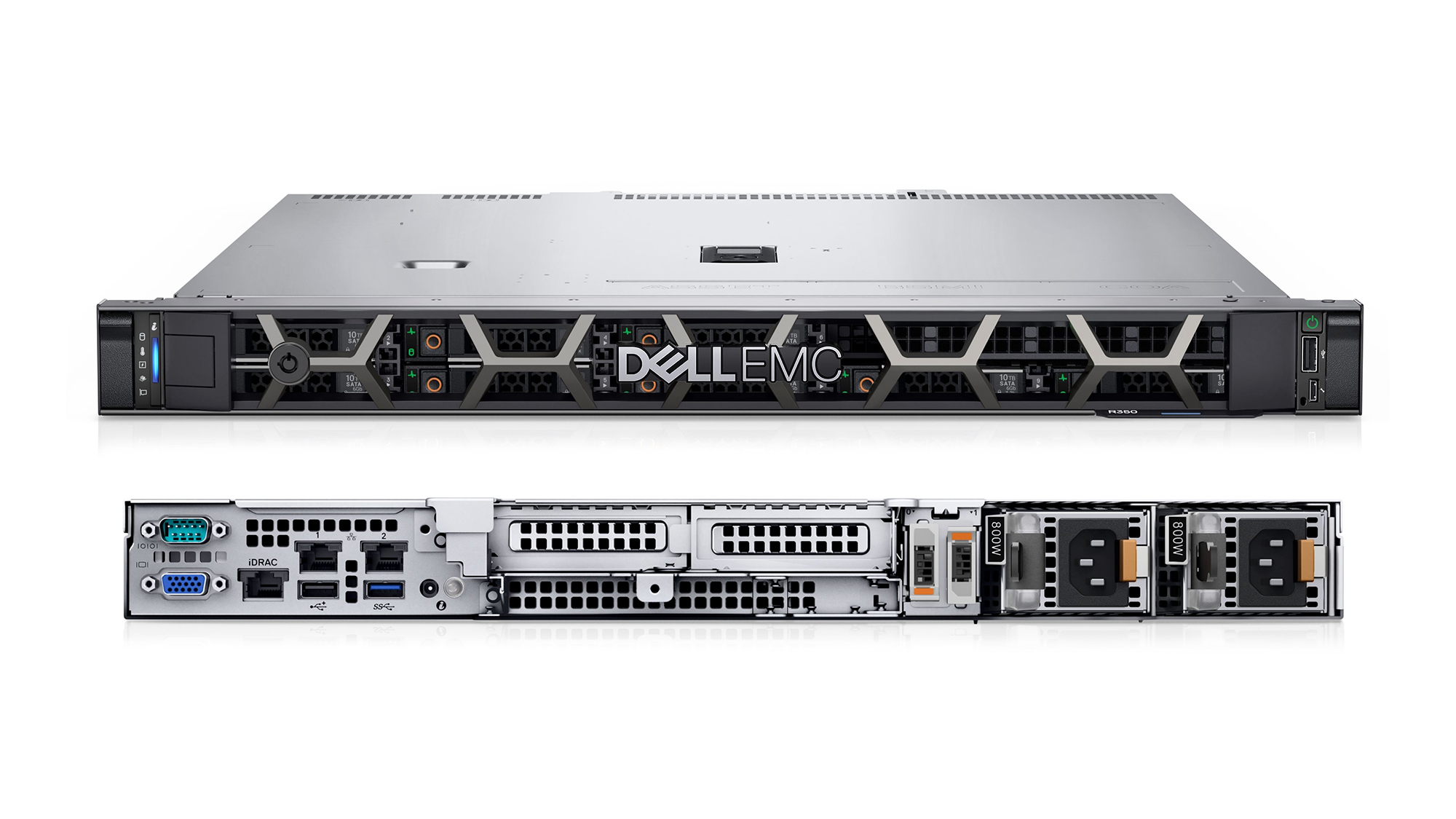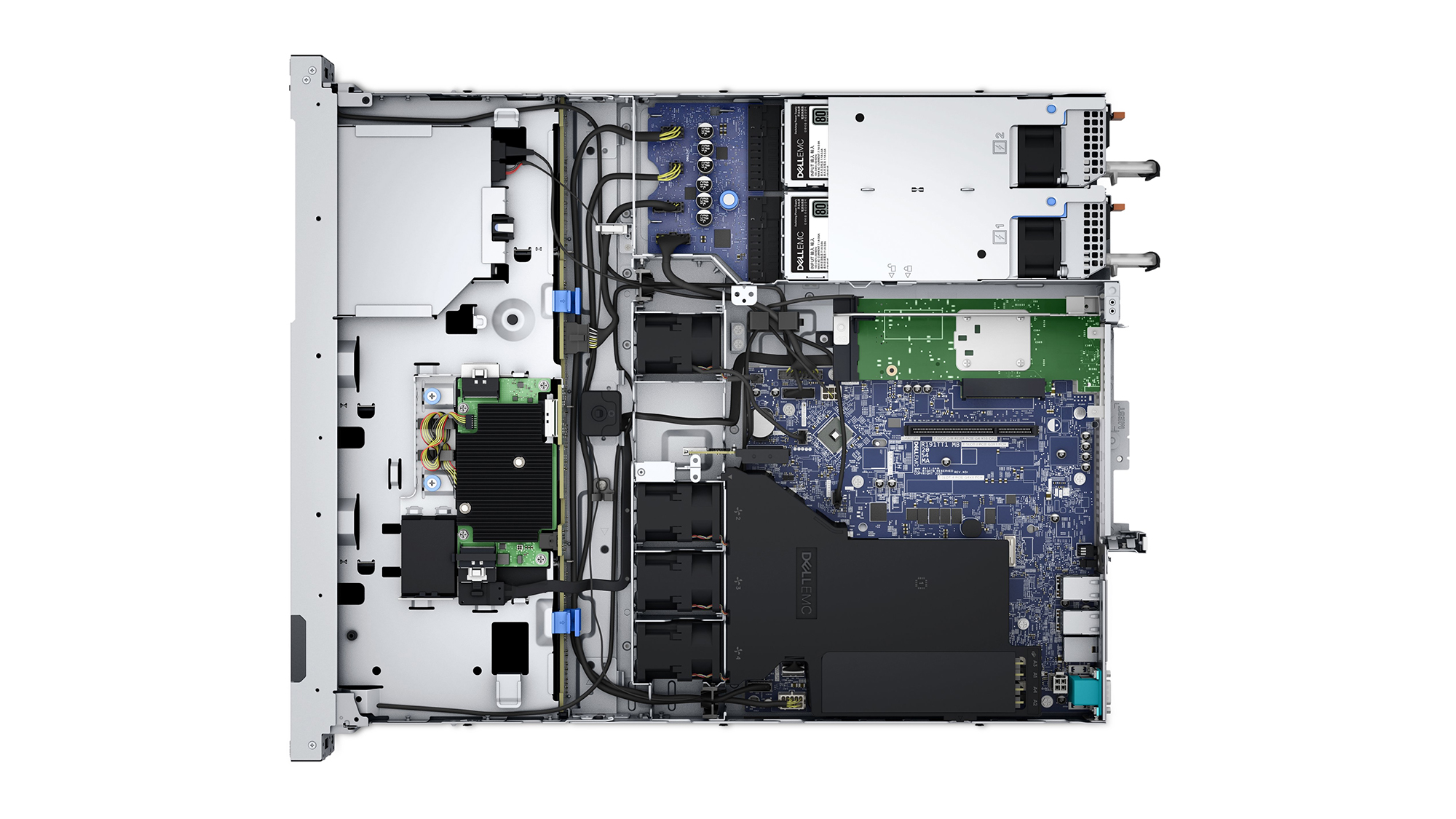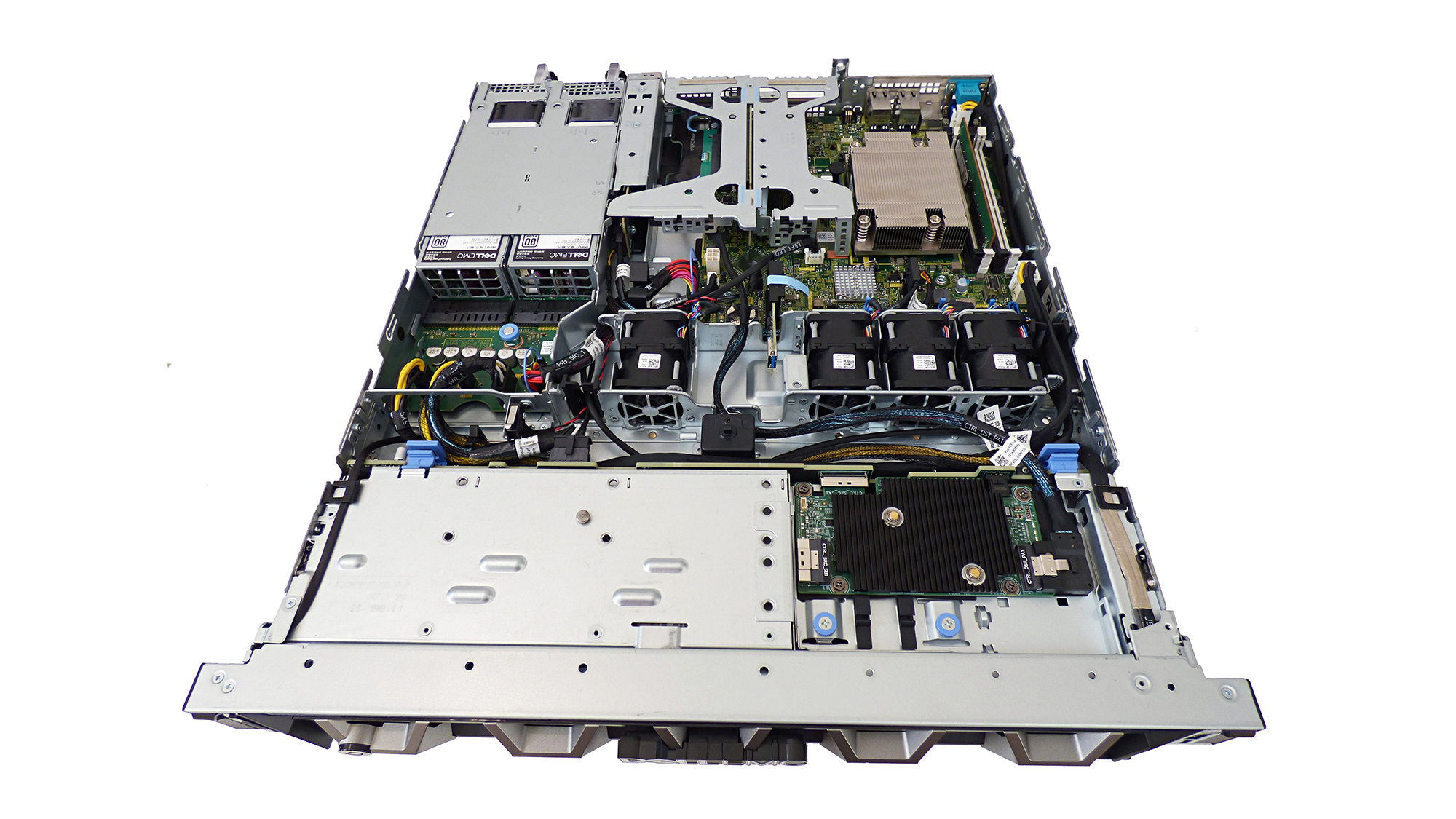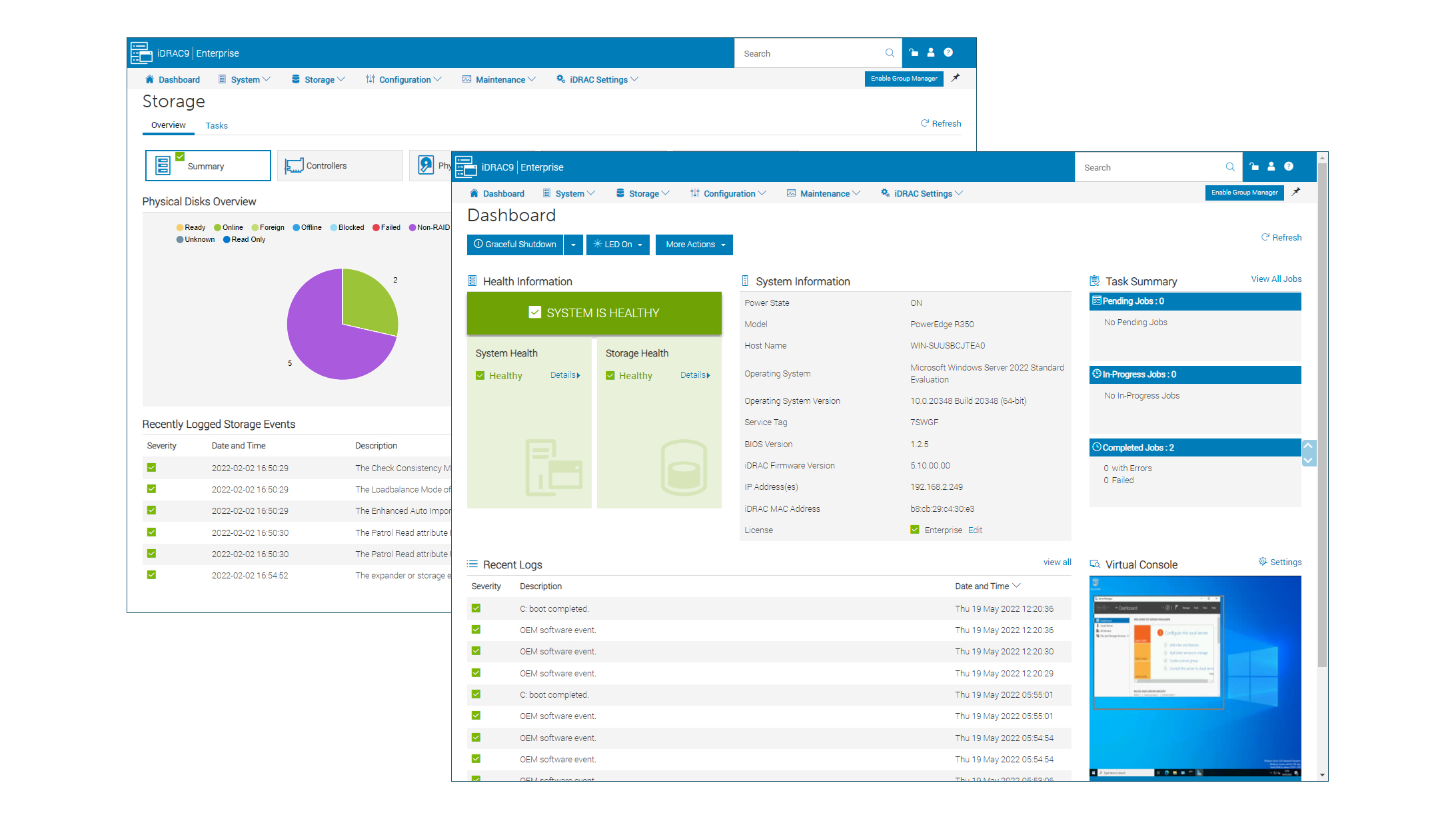Dell EMC PowerEdge R350 review: A compact and powerful server
Dell EMC’s entry-level rack server packs a great specification into a space saving chassis


-
+
Short-depth chassis
-
+
Good expansion potential
-
+
Xeon E-2300 power
-
+
Great storage choices
-
+
Remote management
-
-
Some storage options are expensive

Growing SMBs that need an affordable and scalable entry-level rack server should head over to Dell EMC’s PowerEdge range. The R250 is a good starting point, but for those that want more storage options and greater expansion potential, the R350 on review is a worthy contender.
Along with room up front for four LFF or eight SFF hot-swap drives, this 1U rackmount server supports a choice of eight Dell PERC RAID cards – twice that of the R250. There’s more as it has enough internal real estate for Dell’s smart BOSS (boot optimised storage solution) S2 adapter card with dual hot-swap M.2 SSDs.
It’s also ideal for those with limited space as this 1U rackmount server has a short 585mm depth so it’ll slot into a wall-mount cabinet. This shortness doesn’t come at the cost of features either, as the R350 supports the entire family of ten Xeon E-2300 CPUs and has a maximum memory capacity of 128GB.
Dell EMC PowerEdge R350 review: Design and build
The R350 is very well-built. Removing the lid reveals a tidy interior with cabling neatly tucked away and unrestricted access afforded to all key hardware components. Underneath a plastic air shroud to the right, you’ll find the single CPU socket with the 6-core 2.9GHz Intel Xeon E-2336 in our system topped off with a solid passive heatsink.
The standard heatsink is rated for CPUs up to an 80W TDP so if you specify the 95W Xeon E-2386G or E2388G chips, you’ll get a larger one. To the side of the CPU are four DIMM slots and the price we’ve shown includes a single 32GB stick of 3,200MHz DDR4 memory, leaving three spare slots for boosting this to the maximum 128GB.

Cooling for all versions of the R350 is handled by a bank of four cold-swap, dual-rotor fan modules lined up in front of the motherboard. We initially found their noise levels quite noticeable but after playing around with the management settings and changing the default thermal fan profile to the Sound Cap option, this was reduced considerably.
The 350W hot-plug Bronze PSUs in the previous generation R340 have been upgraded in the R350 to more powerful 600W Platinum 80 Plus models. The server can be run with just one, but our configuration has dual PSUs for added redundancy.
The motherboard offers a pair of embedded Gigabit ports and further expansion is facilitated by a riser card with a PCI-E 4 slot on each side. Both accept half-length (HL), half-height (HH) cards with Dell offering dual or quad port Gigabit and dual copper or SFP+ 10-Gigabit adapters.
Dell EMC PowerEdge R350 review: Storage variables
The R350 supports twice as many PERC cards as the R250 because it has a mount point and connector on the drive backplane for a front RAID card with four versions available. Our system came with an entry-level PERC H345 Front Load adapter which provides SAS3 and SATA support along with hardware-managed RAID0, 1 and 10 arrays - the 700-series of adapters extend these to RAID5 and 6 plus battery protected cache memory.
The H345 card is cabled through to the motherboard and Dell has been quite clever here as there’s a dedicated PCI-E 4 PERC side slot below the riser cage. This has a dual purpose as it accepts standard adapter PERC (aPERC) cards while in our case, it was occupied by a simple front PERC (fPERC) pass-through card servicing the H345 adapter.

For general storage duties, we’ve included two 480GB SATA SSDs but Dell offers a big choice of SAS and SATA HDDs and SSDs. We can’t see many SMBs tempted by Dell’s high capacity models though, as they’re a bit pricey with a 4TB read-intensive SATA SSD costing nearly £3,000.
Still, you won’t need to use them for the operating system as the BOSS S2 card is designed specifically for this task. Tucked up next to the PSU bay, it presents two M.2 SATA SSD slots in hot-swap carriers that can be easily accessed from the rear and we’ve included one with dual mirrored 240GB SSDs.
A hypervisor hosting alternative to the BOSS S2 is Dell’s internal dual SD module (IDSDM) card which has two SD Card slots, supports mirroring and fits in a dedicated slot at the front of the motherboard. If you’re happy to run a hypervisor on a single USB stick, the slot also accepts Dell’s internal USB 3 card which only costs £26.
Dell EMC PowerEdge R350 review: Management choices
It may be an entry-level server but the R350 sports the same iDRAC9 remote controller and dedicated Gigabit port as its bigger PowerEdge brothers. Its smart web console presents a wealth of information on server operations plus a full hardware inventory and direct access to BIOS and storage configurations.
You can choose from five licenses - Basic and Express are very similar, with the latter adding real-time power and temperature graphing. If you want full remote OS control and remote media services though, you’ll need an Enterprise license, while the Datacenter option adds advanced services such as streaming telemetry.

All PowerEdge servers can be managed and monitored from the free OpenManage Enterprise (OME) software which we run in the lab as a Hyper-V VM. Adding an iDRAC9 OME Enterprise Advanced license enables the Power Manager plug-in and as long as you have a valid support contract, you can use the free CloudIQ cloud hosted service which provides server telemetry and predictive analytics.
Dell EMC PowerEdge R350 review: Verdict
The PowerEdge R350 will appeal to SMBs as this entry-level rack server combines Xeon E-2300 power with a high expansion potential, making it a good long-term investment. Storage options are plentiful too, and you won’t find better remote management facilities anywhere else either.
Dell EMC PowerEdge R350 specifications (as reviewed)
| Chassis | 1U rack |
| CPU | 6-core 2.9GHz Intel Xeon E-2336 |
| Memory | 32GB 3,200MHz ECC UDIMM DDR4 (max 128GB) |
| Storage bays | 8 x hot-swap SAS/SATA SFF with Front PERC |
| RAID | Dell PERC H345 Front Load |
| Storage included | 2 x 480GB SATA SFF read-intensive SSDs |
| Other Storage | Dell BOSS S2 with 2 x 240GB M.2 SATA SSDs |
| Network | 2 x Gigabit LOM |
| Expansion | 2 x PCI-E 4, 1 x PCI-E 4 (PERC only), IDSDM/USB 3 card slot |
| Power | 2 x 600W Platinum hot-plug PSUs |
| Other | Static ReadyRails included |
| Management | Dell iDRAC9 Enterprise |
| Warranty | 3Yr Standard On-Site NBD |
Get the ITPro daily newsletter
Sign up today and you will receive a free copy of our Future Focus 2025 report - the leading guidance on AI, cybersecurity and other IT challenges as per 700+ senior executives
Dave is an IT consultant and freelance journalist specialising in hands-on reviews of computer networking products covering all market sectors from small businesses to enterprises. Founder of Binary Testing Ltd – the UK’s premier independent network testing laboratory - Dave has over 45 years of experience in the IT industry.
Dave has produced many thousands of in-depth business networking product reviews from his lab which have been reproduced globally. Writing for ITPro and its sister title, PC Pro, he covers all areas of business IT infrastructure, including servers, storage, network security, data protection, cloud, infrastructure and services.
-
 ‘Phishing kits are a force multiplier': Cheap cyber crime kits can be bought on the dark web for less than $25 – and experts warn it’s lowering the barrier of entry for amateur hackers
‘Phishing kits are a force multiplier': Cheap cyber crime kits can be bought on the dark web for less than $25 – and experts warn it’s lowering the barrier of entry for amateur hackersNews Research from NordVPN shows phishing kits are now widely available on the dark web and via messaging apps like Telegram, and are often selling for less than $25.
By Emma Woollacott Published
-
 Redis unveils new tools for developers working on AI applications
Redis unveils new tools for developers working on AI applicationsNews Redis has announced new tools aimed at making it easier for AI developers to build applications and optimize large language model (LLM) outputs.
By Ross Kelly Published
-
 Google layoffs continue with "hundreds" cut from Chrome, Android, and Pixel teams
Google layoffs continue with "hundreds" cut from Chrome, Android, and Pixel teamsNews The tech giant's efficiency drive enters a third year with devices teams the latest target
By Bobby Hellard Published